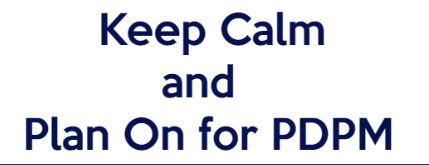When PDPM was finalized in July’s final rule, there was no stopping the development of training and resources by those in our industry who make us successful. It’s what educators do, dissect, synthesize and disseminate information. However, PDPM’s outline in the final rule lacked detail in certain areas and created questions in others. Chances are, some of the training and resources you have saved (even CMS’) are now inaccurate or incomplete.
During the Medicare Learning Network call earlier this month many elements of PDPM were clarified and a few were introduced including:
1. Mapping to the PDPM clinical category will come from new items set, I0020B (What’s the main reason this person is being admitted to the SNF?) coupled with possible responses to new item set J2100-J5000 (Surgical procedures that occurred during the inpatient hospital stay that immediately preceded the SNF admission).
2. PDPM classification groups designated under administrative presumption including
a. Nursing groups within Extensive Services, Special Care High, Special Care Low, and Clinically Complex,
b. PT and OT groups TA, TB, TC, TD, TE, TF, TG, TJ, TK, TN, and TO,
c. SLP groups SC, SE, SF, SH, SI, SJ, SK, and SL; and d. NTA highest category of 12+.
3. Revised Health Insurance Prospective Payment System (HIPPS) coding algorithm.
4. Further instruction on the Interim Payment Assessment including use of Interim Section GG column for reporting and look back.
5. Addition of Optional State Assessment for Medicaid determination (Not a Part A PPS assessment).
6. Examples to clarify Interrupted stay policy and group and concurrent calculation.
7. Extensive instruction on RUG-IV and PDPM transition and mandated transitional IPA if patient is receiving skilled part A services prior to 10/1/2019 and continuing.
8. RAI Manual draft expected “early” 2019.
So with all of the PDPM chatter, how do we filter for quality and accuracy? How do we trust the resource we have is accurate and up to date? Here are a few tips for just that:
1. Gather information from multiple sources. Subscribe to industry leaders and state associations for updates. Read the Reliant Reveal and Real Time Memos as they arrive.
2. Take it a step at a time. No one becomes an expert overnight. Start with the clinical component and case mix groups, then move on to ICD-10 coding, or assessment time frames and rules, but be confident in one element before you begin learning the next.
3. Look for cited sources (RAI Manual, CMS material) and revision dates to resource materials. CMS has indicated they will begin time stamping the FAQ documents to indicate revisions made. Resources from other entities should do the same.
4. When possible, go to CMS webpage for clinical and NTA crosswalk information. These references are available in savable zip file format but have been updated at least two times since their initial release in August.
5. If something clicks and suddenly makes sense, write it down. Don’t assume you’ll remember.
6. Ask questions! If a comment or statement does not make sense, ask for clarification and citation.
Your partners in patient care should want to support you in your journey for knowledge and a successful transition to PDPM. Reliant is ready to keep you up to date, answer your questions, and problem solve for strategic success!


